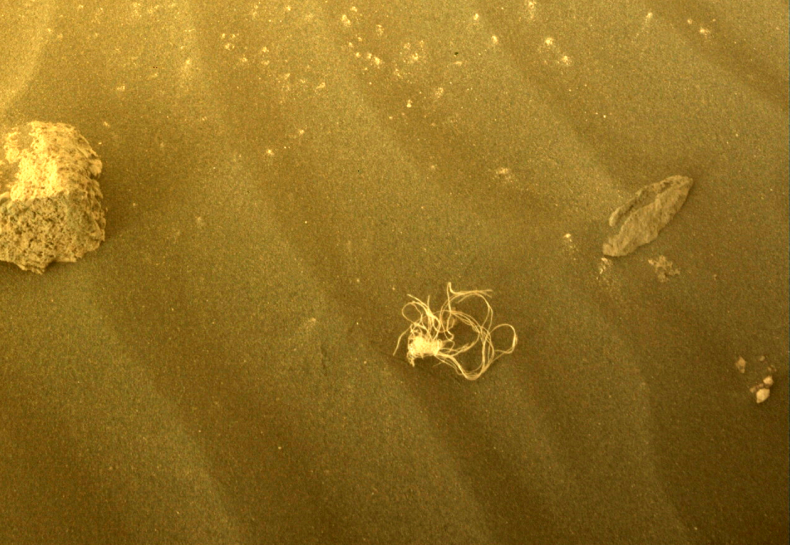Spaghetti? String cheese? landing trash?
The Perseverance rover from NASA has discovered something on the surface of Mars, most likely the last one, and the internet is searching for information about it.
The stringy thing was photographed by Perseverance on July 12, 2022, the 495th day of the rover’s ongoing mission to investigate the red planet. It was snuggled in the sand between several plain Martian boulders.
The image is seen below, along with another shot from a different angle that helps illustrate the object’s size since it is situated right beneath Perseverance, close to its wheels.

NASA/JPL-Caltech

The nature of the object is unknown.
It appears to be a bundle of string upon closer study, which begs the issue of how it got there.
In any case, the image quickly gained widespread notice. After the object was uploaded online, people started asking for further information just a few days later.
Naturally, the majority were making jokes, with many comparing the item to a bundle of spaghetti.
It might also be compared to string cheese.
One user said, “I knew the Martians were Italian!”
Another echoed the well-known Eminem verse: “Knees weak, hands sweating, there’s dust on my solar panels already, Mars spaghetti.”
As a result of a weekly public poll, the picture of the object ascended to become Perseverance’s Image of the Week. The object is likely a piece of debris ejected by Perseverance itself, probably during its parachute-assisted landing maneuver back in February 2021, according to news outlet CNET.
This has happened before, so it wouldn’t be the first time.
Perseverance discovered the parachute it used to touch down on Mars back in April of this year.
A glossy piece of foil that had served as Perseverance’s thermal blanket throughout its descent was also found by the rover in June. At the moment, the rover’s official Twitter account stated, “It’s a surprise finding this here.”
“My descent stage collapsed 1.2 miles (approximately 2 km) distant.
That shiny bit of foil is part of a thermal blanket – a material used to control temperatures. It’s a surprise finding this here: My descent stage crashed about 2 km away. Did this piece land here after that, or was it blown here by the wind? pic.twitter.com/uVx3VdYfi8
— NASA’s Perseverance Mars Rover (@NASAPersevere) June 15, 2022
What’s missing right now is an official NASA explanation for the recently discovered spaghetti-like item, whatever it may be. The space agency has been approached by Newsweek for comment.
Perseverance and its older robotic coworker Curiosity are frequently eager to draw attention from the public when they shoot mysterious Martian photographs.
A gateway in a Martian rock and another image that looked to depict a humanoid shape lying down caused a lot of discussion earlier this year.
Regarding the latter, NASA scientist Mitch Schulte previously stated to Newsweek that Mars is believed to be completely unfriendly to life as we currently understand it.
NOTE:
Perseverance
As part of NASA’s Mars 2020 project, Perseverance, also known as Percy, is a car-sized Mars rover created to explore the Jezero crater on Mars.
The Jet Propulsion Laboratory created it, and on July 30, 2020, at 11:50 UTC, it was launched.
On February 18, 2021, at 20:55 UTC, confirmation that the rover had successfully landed on Mars was received.
Perseverance has been operational on Mars for 497 sols (511 Earth days), or 1 year, 4 months, and 26 days, as of July 14, 2022.
NASA gave the landing place the name Octavia E. Butler Landing after the rover touched down there.
The architecture of Perseverance is identical to that of Curiosity, the rover it replaced but with minor improvements. Nineteen cameras, two microphones, and seven principal payload instruments are all aboard.
Ingenuity to Mars, an experimental aircraft and technology testbed that performed the first powered flight on an alien planet on April 19, 2021, was also transported by the rover.
It has completed 26 successful flights as of April 21, 2022. On April 8, 2022, Ingenuity completed its 25th successful flight, at which time it broke records for both speed and distance covered in a single trip.
The rover’s objectives include locating past environments on Mars that could have supported life, looking for signs of past microbial life there, gathering rock and soil samples to store on the Martian surface, and testing oxygen production from the Martian atmosphere to prepare for crewed missions in the future.






